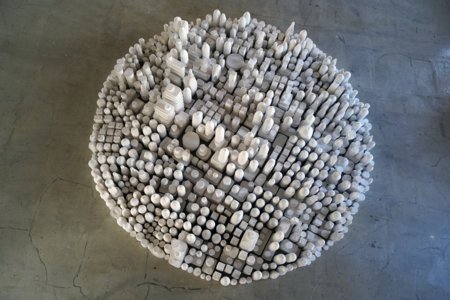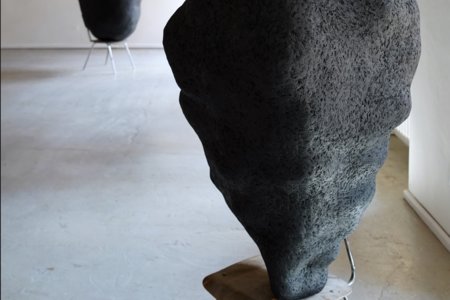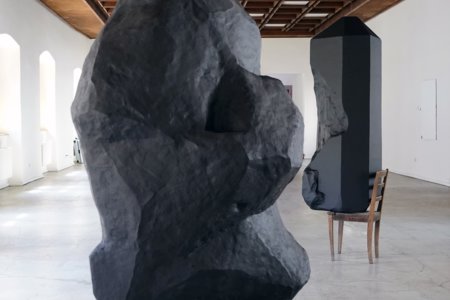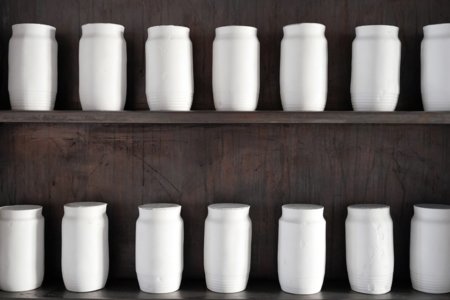CURATOR: NORO LACKO
DURATION: 3. 6. – 29. 10. 2023
OPENING: 2. 6. 2023, 6 PM
PARTNERS: BANSKÁ BYSTRICA SELF–GOVERNING REGION, CHATEAU TOPOĽČIANKY
The works of Marek Kvetan, a Slovak multimedia artist (born in 1976, Bratislava), graduate, and currently a lecturer at the Academy of Fine Arts in Bratislava, have undergone significant transformations during his over twenty-year involvement in the Slovak and, without exaggeration, European visual art scene. His initial foundations, rooted in the subtlety of dematerializing digital media and manipulated digital prints, have evolved into absurd, ironic, noisy, and above all robust three-dimensional object-sculptural installations. Kvetan's more recent works sharply comment on the media frenzy of instant surrogate pseudo-realities that refine the contemporary world, as well as on classical ethical and non-classical aesthetic sins such as luxury and bad taste.
In his recent works, Marek Kvetan presents himself in a relatively darker and more serious tone. The subtle, rational depreciation, as well as the lightening with irony, is replaced by a sophisticated intertwining of meaningful references. The loud noise is replaced by a contemplative quietude of atmosphere, relying on a reduction of color, light, or form. The unbearable sharpness of the joke bordering on mockery of the here and now is replaced by openness to posed questions or rather an invitation to question, to inquire about possible futures, and to examine familiar and hidden versions of the past.
In the prophetic variability that characterizes Marek Kvetan's artistic thinking, it is still possible to identify several common denominators. First and foremost, there is a trust in the forms of visual art that intertwine post-conceptual games of reason, a post-productive delight in finding and quoting, paraphrasing and transforming existing objects from the natural or artificial world, and a strict, somewhat unconventional emphasis on precise craftsmanship and technologically thorough realization of the artwork. These could be the fundamental components of the substrate from which the layered and layered layers of meaning in Kvetan's artistic works are subsequently kneaded.
For the current exhibition, composed of a selection of Marek Kvetan's recent works, we have chosen the title "Petrus" - stone, rock, rocky, or stony - considering it in a completely secular, non-religious spirit, referring to the biblical verses of the Gospel of Matthew (16, 18): "You are Peter, and on this rock, I will build..." and asking what was, what is, what will be, or what could be the rock on which a community, a civilization, a human society stands, will stand, or could stand. However, we also thought about petrification, fossilization, the preservation of life and the living, which can be perceived both as a merciful process of preserving and safeguarding traces and memories, and as a merciless retarding of life, a stagnation, a dullness of thought. The literal and metaphorical references to the stone and petrification are one of the possible unifying elements of the exhibited works collection.
The monumental linear set of six stones placed on stools, titled "Cornerstone" (2020), is a visual essay on the twists and folds of the interrelations between the mineral world and human history. The sculptural, formally reduced paraphrases or rather sculptural distillations of the morphology of various specific rocks, minerals, and ores from Central European, especially Czechoslovak, history (Jáchymov pitchblende, Banská Štiavnica crystal, general fieldstone, coal, meteorite, erratic boulder) are at the same time the foundational stones of civilization, coal or wedge stones holding the structure together, stones of impact affecting global civilizations as well as individual human destinies. They are extracted, but they are also a burden, a weight that needs to be carried. The stool has been a reference to the presence of humanity, its social status, position, and societal role in visual art. An empty stool signified a deficient form of absence or a traumatizing representation of an inhumane world, a world that has lost its human dimension. The stools in the Cornerstone set are found objects originating from specific locations in human history, just as the stones on which they rest come from specific geological time and space. What stories does the stool from the Jáchymov prison hospital tell? And what is the memorial of the stool from the Banská Štiavnica miners' house from the late 17th and early 18th centuries, indicating the decline in demand for Štiavnica silver and the subsequent degradation of the entire region?
Playing with petrification and the creation of fossils for the nearest possible future (if there will be one), as well as the relationship between human corporeality and the mineral world, is explored in the diptych composed of "Datastorage 20.21" (2020/2021) and "Databox 2.0" (2020/2021). It was created as a procedural, almost contemplative work, the daily routine of an artist who, during the strict quarantine of the Covid-19 year, preserved and subsequently cast in plaster the volumes of all the packaging from consumed food items. In the time of the pandemic, physical threats and the fear of possible infection turned otherwise mundane daily acts of sustenance, such as consuming food, fluids, and most importantly, breathing, into burdensome, paranoid adventures. And then there were the packaging materials, accumulating piles of packaging. We installed them in the form of a phantasmagoric city, an urban landscape with a circular footprint, a city as a product of human bodily and spiritual metabolism, a city as a source and a city as a residue (Datastorage 20.21), and in a form that combines elements of a shelf, a laboratory cabinet, and a museum repository, resembling an exhibition of a collection of fossils of the chemical body (Databox 2.0).
TEXT BY: NORO LACKO
- About us
- Fee
- Opening hours
- Calendar
-
Collections
- Mining engineering
- Mining surveying
- Mining shafts
- Mining adits
- Clappers
- Montane archeology
- Miners´celebrations
- Lighting in mines
- Mining works
- Tajchy - water reservoirs in Banská Štiavnica and surroundings
- Modification of mineral raw materials
- Rescue service
- Dubník
- Handlová
- Kremnica
- Nižná Slaná
- Smolník
- Špania Dolina
- Mining and Forestry Academy - professors and buildings
- Mining and Forestry Academy - academics, salamander, “šachtág” - student habits
- Banská Hodruša
- Ľubietová
- Banská Belá
- Štiavnické Bane
- Rudňany
- Rožňava
- Banská Štiavnica
- Banky
- Vyhne
- Sklené Teplice
- Prenčov
- Ilija
- Banská Bystrica
- Nová Baňa
- Vyšná Boca
- Prešov
- Železník
- School in the museum
- Green museum
- Photo gallery










